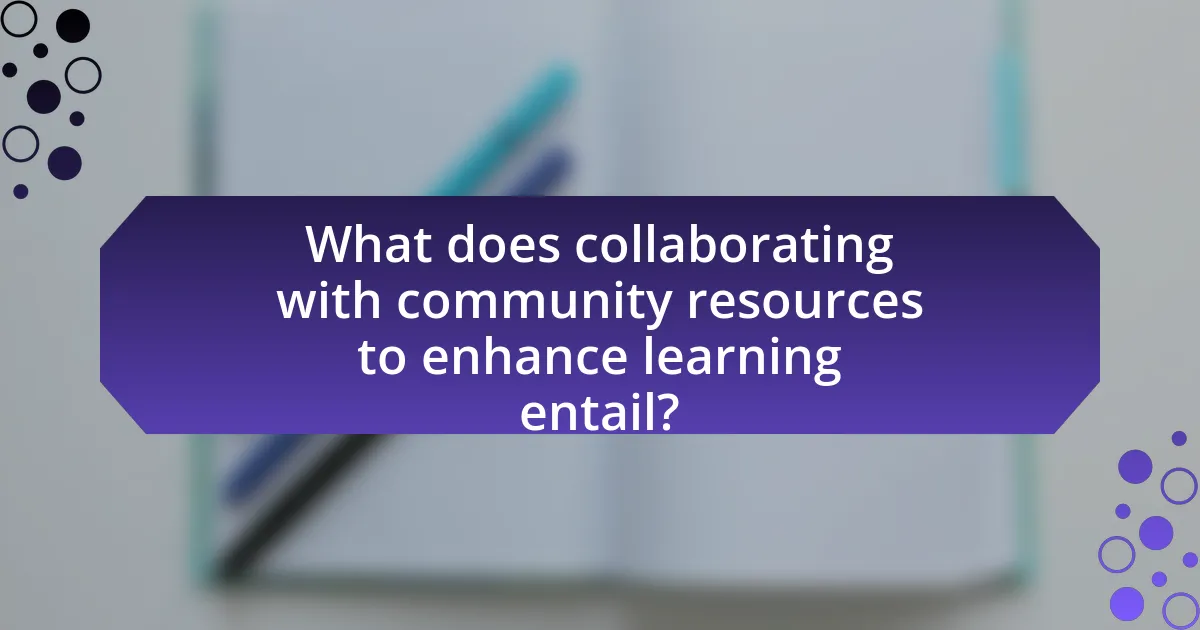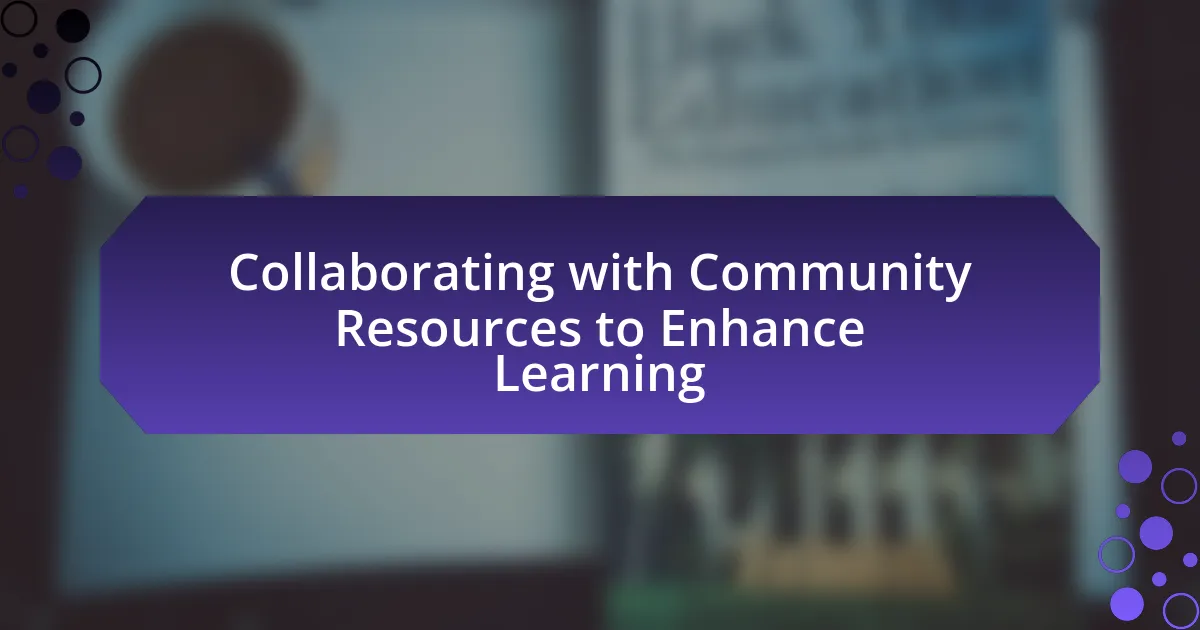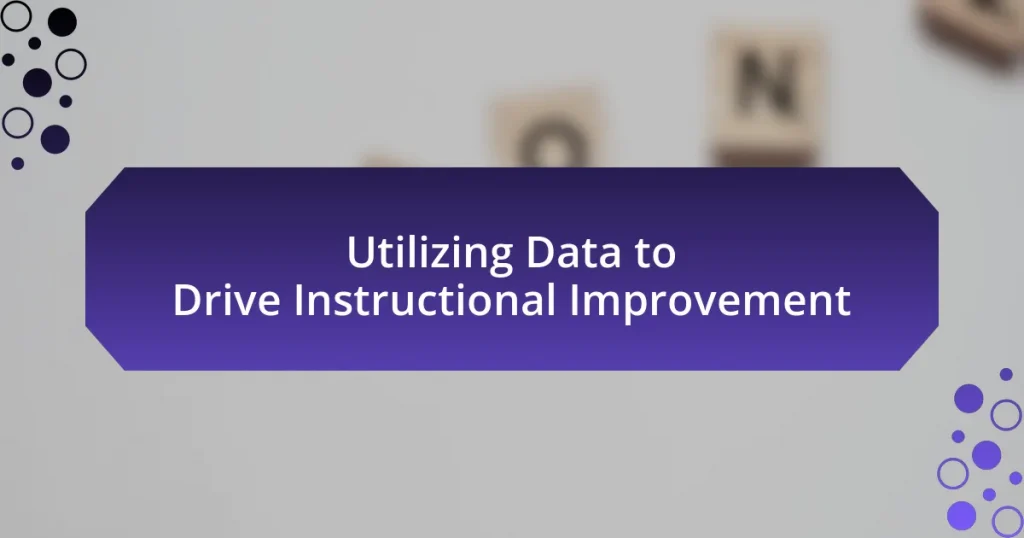Collaborating with community resources to enhance learning involves forming partnerships between educational institutions and local organizations to provide students with additional support and resources. This collaboration can improve student engagement and academic performance through access to libraries, mentorship programs, and internships. The article explores how community resources align with educational goals, the benefits of such collaborations for students and teachers, and strategies for effective partnership development. It also addresses potential challenges, misconceptions, and the importance of ongoing evaluation and community feedback in fostering successful educational outcomes.

What does collaborating with community resources to enhance learning entail?
Collaborating with community resources to enhance learning entails forming partnerships between educational institutions and local organizations to provide students with additional support and resources. This collaboration can include access to libraries, museums, after-school programs, and local businesses that offer mentorship or internships. Research indicates that such partnerships can improve student engagement and academic performance, as evidenced by a study from the National Education Association, which found that schools with strong community ties reported higher student achievement and lower dropout rates.
How can community resources support educational initiatives?
Community resources can support educational initiatives by providing funding, expertise, and facilities that enhance learning opportunities. For instance, local businesses often sponsor educational programs, which can lead to increased resources for schools. Additionally, community organizations may offer mentorship programs, bringing in professionals to share their knowledge and skills with students, thereby enriching the curriculum. Research indicates that schools collaborating with community resources see improved student engagement and academic performance, as evidenced by a study from the Harvard Family Research Project, which found that partnerships with community organizations significantly boost student achievement and well-being.
What types of community resources are available for educational collaboration?
Community resources available for educational collaboration include local libraries, community centers, non-profit organizations, businesses, and educational institutions. These resources provide various support services such as tutoring programs, workshops, mentorship opportunities, and access to educational materials. For instance, libraries often offer free access to books, technology, and learning programs, while community centers may host after-school activities that enhance student learning. Non-profit organizations frequently partner with schools to provide specialized programs, and local businesses can offer internships or sponsorships that enrich educational experiences.
How do these resources align with educational goals?
Community resources align with educational goals by providing supplementary support that enhances student learning and engagement. These resources, such as local organizations, libraries, and mentorship programs, offer practical experiences and diverse perspectives that complement traditional classroom instruction. For instance, partnerships with local businesses can facilitate internships, allowing students to apply their knowledge in real-world settings, thereby improving their skills and readiness for future careers. Research indicates that students who engage with community resources demonstrate higher academic achievement and improved social skills, reinforcing the importance of collaboration in achieving educational objectives.
Why is collaboration with community resources important for learning?
Collaboration with community resources is important for learning because it enhances educational opportunities and provides real-world context. Engaging with local organizations, businesses, and experts allows learners to access diverse knowledge and skills that complement traditional education. For instance, partnerships with libraries can offer students access to research materials and workshops, while collaboration with local businesses can provide internships and hands-on experiences. Research shows that students involved in community-based learning programs demonstrate improved academic performance and greater engagement, as evidenced by a study conducted by the National Service-Learning Clearinghouse, which found that service-learning participants had higher grades and increased retention rates.
What are the potential benefits of such collaborations for students?
Collaborations with community resources provide students with enhanced learning opportunities, practical experience, and access to diverse expertise. These partnerships often lead to real-world applications of classroom knowledge, allowing students to engage in projects that address community needs. For instance, a study by the National Education Association found that students involved in community-based projects showed a 20% increase in engagement and a 15% improvement in academic performance compared to their peers not involved in such initiatives. Additionally, these collaborations foster essential skills such as teamwork, communication, and problem-solving, which are critical for future career success.
How does collaboration impact teachers and educational institutions?
Collaboration significantly enhances the effectiveness of teachers and educational institutions by fostering shared resources, knowledge, and support systems. When teachers collaborate, they can exchange best practices, leading to improved instructional strategies and student outcomes. Research indicates that collaborative teaching models, such as co-teaching, can increase student engagement and achievement, as evidenced by a study published in the “Journal of Educational Psychology,” which found that collaborative approaches led to a 20% increase in student performance in math and reading assessments. Furthermore, educational institutions that engage with community resources through partnerships can access additional funding, expertise, and learning opportunities, thereby enriching the educational experience and promoting a more holistic approach to student development.

What strategies can be employed for effective collaboration?
Effective collaboration can be achieved through clear communication, defined roles, and mutual respect among team members. Clear communication ensures that all participants understand objectives and expectations, which is supported by studies indicating that teams with open communication channels are 25% more productive. Defined roles help to clarify responsibilities, reducing overlap and confusion, while mutual respect fosters a positive environment that encourages idea sharing and innovation. Research from the Harvard Business Review highlights that teams with high levels of respect and trust are 50% more likely to achieve their goals.
How can educators identify suitable community partners?
Educators can identify suitable community partners by assessing the alignment of community organizations’ missions with educational goals. This involves researching local organizations, evaluating their programs, and determining their capacity to support specific learning objectives. For instance, partnerships with local libraries can enhance literacy programs, while collaborations with health organizations can support wellness initiatives. Additionally, educators can engage in community networking events to establish connections and gather insights about potential partners’ resources and expertise. This approach ensures that partnerships are mutually beneficial and effectively enhance the learning experience.
What criteria should be considered when selecting community resources?
When selecting community resources, criteria such as relevance, accessibility, credibility, and sustainability should be considered. Relevance ensures that the resources align with the educational goals and needs of the community. Accessibility refers to the ease with which community members can utilize these resources, including physical location and availability of services. Credibility involves evaluating the qualifications and reputation of the resource providers, ensuring they have a proven track record in their respective fields. Sustainability assesses whether the resources can be maintained over time, ensuring long-term benefits for the community. These criteria collectively enhance the effectiveness of collaboration with community resources in educational settings.
How can educators build relationships with community organizations?
Educators can build relationships with community organizations by actively engaging in collaborative projects that align educational goals with community needs. This can involve organizing joint events, such as workshops or service-learning projects, where both educators and community members contribute their expertise and resources. Research indicates that partnerships between schools and community organizations can enhance student learning outcomes, as seen in studies like the one conducted by the Coalition for Community Schools, which found that such collaborations lead to improved academic performance and increased student engagement. By fostering open communication and establishing mutual goals, educators can create sustainable partnerships that benefit both students and the community.
What methods can be used to integrate community resources into the curriculum?
Methods to integrate community resources into the curriculum include partnerships with local organizations, service-learning projects, and guest speaker programs. Partnerships with local organizations allow schools to access expertise and resources that enhance educational content, such as museums providing educational materials or local businesses offering internships. Service-learning projects engage students in community service that aligns with academic objectives, fostering real-world application of classroom knowledge. Guest speaker programs invite community members to share their experiences and expertise, enriching the curriculum with diverse perspectives. These methods have been shown to improve student engagement and learning outcomes by connecting academic content to real-life contexts.
How can project-based learning incorporate community resources?
Project-based learning can incorporate community resources by actively engaging local organizations, businesses, and experts to provide real-world context and support for student projects. This collaboration allows students to apply their learning in practical settings, enhancing their understanding and skills. For instance, partnerships with local environmental organizations can facilitate projects focused on sustainability, where students conduct research and implement solutions in their community. Such initiatives not only enrich the educational experience but also foster a sense of civic responsibility and connection to the community.
What role do community experts play in enhancing learning experiences?
Community experts play a crucial role in enhancing learning experiences by providing specialized knowledge and real-world insights that enrich educational content. Their involvement allows learners to connect theoretical concepts with practical applications, fostering deeper understanding and engagement. For instance, when local professionals participate in classroom discussions or workshops, they share firsthand experiences that illustrate the relevance of academic subjects, thereby making learning more relatable and impactful. Research indicates that students exposed to community experts demonstrate improved critical thinking skills and increased motivation, as these interactions bridge the gap between education and the community.

What challenges might arise in collaborating with community resources?
Collaborating with community resources can present challenges such as differing priorities among stakeholders, communication barriers, and resource limitations. Differing priorities can lead to conflicts in objectives, as community organizations may focus on specific needs that do not align with educational goals. Communication barriers often arise from varying levels of understanding and terminology used by different organizations, which can hinder effective collaboration. Additionally, resource limitations, including funding and personnel, can restrict the ability of both educational institutions and community organizations to fully engage and sustain collaborative efforts. These challenges are documented in studies highlighting the complexities of partnerships in educational settings, such as the research conducted by the Harvard Family Research Project, which emphasizes the importance of aligning goals and maintaining open communication for successful collaboration.
How can communication barriers affect collaboration?
Communication barriers can significantly hinder collaboration by creating misunderstandings and reducing the effectiveness of information exchange. When team members cannot convey their ideas clearly due to language differences, cultural misunderstandings, or technological issues, it leads to confusion and misalignment on goals and tasks. Research indicates that effective communication is crucial for teamwork; for instance, a study published in the Journal of Business Communication found that 70% of workplace failures are attributed to poor communication. This statistic underscores the importance of addressing communication barriers to foster a collaborative environment that enhances learning and resource sharing within communities.
What strategies can be implemented to overcome these barriers?
To overcome barriers in collaborating with community resources to enhance learning, organizations can implement strategies such as establishing partnerships with local businesses and educational institutions. These partnerships can provide access to resources, expertise, and funding, which are essential for effective collaboration. For instance, a study by the National Education Association found that schools that partnered with local businesses reported a 20% increase in student engagement and achievement. Additionally, leveraging technology to facilitate communication and resource sharing among stakeholders can streamline collaboration efforts, making it easier to coordinate activities and share information.
How can differing goals between educators and community partners be reconciled?
Differing goals between educators and community partners can be reconciled through open communication and collaborative goal-setting. Establishing a shared understanding of each party’s objectives allows for the identification of common ground. For instance, educators may prioritize student academic success, while community partners might focus on social development. By engaging in regular dialogue, both parties can align their goals to create mutually beneficial programs. Research indicates that partnerships with clear, shared objectives lead to improved outcomes; a study by the Harvard Family Research Project found that effective collaboration enhances student learning and community engagement.
What are common misconceptions about community collaboration in education?
Common misconceptions about community collaboration in education include the belief that it is solely the responsibility of schools to engage with the community and that such collaboration is only beneficial for students from disadvantaged backgrounds. Many educators assume that community involvement does not significantly impact overall student achievement, despite research indicating that schools with strong community ties often see improved academic outcomes. Additionally, some stakeholders think that collaboration requires extensive resources and time, while studies show that even small, consistent partnerships can yield positive results.
How can these misconceptions be addressed to foster better partnerships?
Misconceptions can be addressed by implementing clear communication strategies and establishing mutual goals among partners. Effective communication ensures that all parties understand each other’s roles, expectations, and contributions, which minimizes misunderstandings. For instance, regular meetings and feedback sessions can facilitate open dialogue, allowing partners to clarify their perspectives and align their objectives. Research indicates that organizations that prioritize transparent communication experience a 25% increase in partnership satisfaction, as reported in the Journal of Collaborative Learning. By fostering an environment of trust and collaboration, misconceptions can be effectively mitigated, leading to stronger partnerships.
What evidence supports the effectiveness of community collaboration in education?
Community collaboration in education is supported by evidence showing improved student outcomes, increased engagement, and enhanced resource availability. Studies indicate that schools partnering with local organizations experience higher student achievement; for instance, a report by the Coalition for Community Schools found that students in community school programs had better attendance and academic performance compared to those in traditional schools. Additionally, the National Education Association highlights that community involvement leads to increased parental engagement, which correlates with higher student success rates. Furthermore, research published in the Journal of Educational Psychology demonstrates that collaborative efforts between schools and community entities foster a supportive learning environment, ultimately benefiting students’ social and emotional development.
What best practices should be followed for successful collaboration?
Successful collaboration requires clear communication, defined roles, and mutual respect among all participants. Clear communication ensures that everyone understands objectives and expectations, which is supported by research indicating that effective communication can improve team performance by up to 25%. Defined roles help to clarify responsibilities, reducing confusion and overlap, while mutual respect fosters a positive environment conducive to teamwork. Additionally, establishing common goals aligns efforts and enhances commitment, as studies show that teams with shared objectives are more likely to achieve successful outcomes.
How can ongoing evaluation improve collaborative efforts?
Ongoing evaluation can improve collaborative efforts by providing continuous feedback that informs decision-making and enhances communication among team members. This iterative process allows collaborators to identify strengths and weaknesses in their approach, facilitating timely adjustments that align with shared goals. Research indicates that organizations employing ongoing evaluation mechanisms report higher levels of engagement and satisfaction among participants, as it fosters a culture of accountability and transparency. For instance, a study by the American Evaluation Association found that projects with regular evaluation checkpoints are 30% more likely to meet their objectives compared to those without such practices.
What role does community feedback play in enhancing learning outcomes?
Community feedback plays a crucial role in enhancing learning outcomes by providing insights that inform instructional practices and curriculum development. When educators receive feedback from community members, they can identify gaps in student understanding and adjust their teaching strategies accordingly. Research indicates that schools that actively engage with their communities and incorporate feedback see improved student performance; for instance, a study by the Harvard Family Research Project found that schools with strong community ties and feedback mechanisms had higher student achievement rates. This demonstrates that community feedback not only fosters a collaborative environment but also directly contributes to more effective learning experiences.



